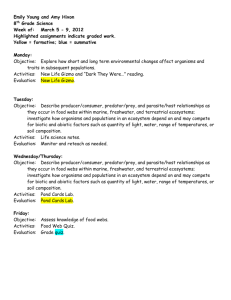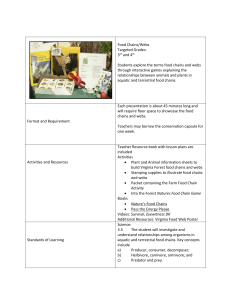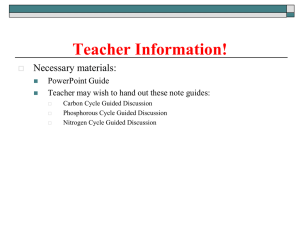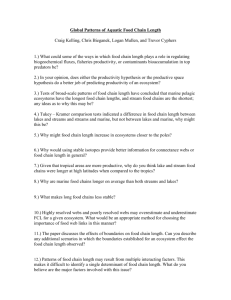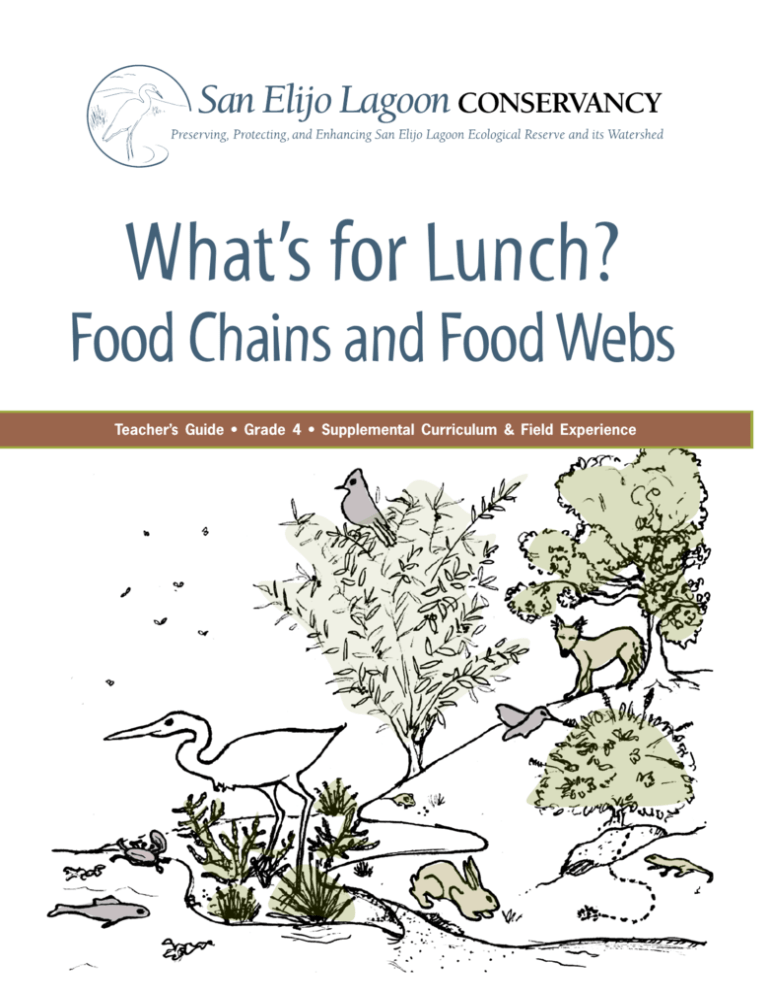
What’s for Lunch?
Food Chains and Food Webs
Teacher’s Guide • Grade 4 • Supplemental Curriculum & Field Experience
TEACHER OVERVIEW
Objectives
From the information and activities in this packet, students will gain:
• An understanding of what food chains and food webs are and how they work.
• An awareness of the food webs of several San Elijo Lagoon habitats and how they’re linked.
• Familiarity with some of the plants and animals that rely on the lagoon for their survival.
California State Standards
This packet will assist you in meeting these Science Content Standards for California Public Schools,
which focus on organisms’ need for energy and matter to live and grow and their dependence on one
another and their environment for survival.
4.2a.
Students know plants are the primary source of matter and energy entering most food chains.
4.2b.
Students know producers and consumers (herbivores, carnivores, omnivores, and decomposers) are related in food chains and food webs and may compete with each other for resources in an ecosystem.
4.2c.
Students know decomposers, including many fungi, insects, and microorganisms, recycle matter from dead plants and animals. 4.3a.
Students know that ecosystems can be characterized by their living and nonliving components.
Vocabulary
abiotic
non-living components of an ecosystem; something that was never alive
algae
photosynthetic organisms, ranging in size from giant kelp to microscopic phytoplankton, that serve as food for many animals, including those in the lagoon (plural, algae; singular, alga)
bacteria
microscopic, single-celled organisms that serve many ecological roles, some harmful and some helpful, including breaking down organic matter (e.g., dead leaves) and releasing nutrients into the environment (plural, bacteria; singular, bacterium)
biotic living components of an ecosystem, such as the plants and animals
carnivore an animal that eats only other animals (e.g., hawk or lizard)
San Elijo Lagoon Conservancy | Food Chains & Food Webs Teacher’s Guide | Page 1
TEACHER OVERVIEW continued
coastal sage scrub a habitat growing on drier coastal slopes that consists of drought- resistant shrubs and other plants
component
a part of something; a smaller part of a larger entity or system
consumer an animal that gets its energy by eating other plants or animals
decomposer
a living thing (organism) that breaks down the remains of dead organisms (e.g., some insects, crabs, fungi, or bacteria)
ecosystem
all the living and nonliving things that interact in an area
energy
the capacity to be active, or, as defined in physics, to do work
food chain
the path of food energy in an ecosystem from sunlight to plants to animals
food web a system of interconnected food chains
fungi a group of organisms, including mushrooms, yeast, and mold, which feeds on living and dead organic matter or material (plural, fungi; singular, fungus)
habitat a specific type of environment inhabited by particular animal and
plant species
herbivore an animal that eats only plants (e.g., rabbit or deer)
lagoon
a body of water cut off from another larger body of water by sand, coral or reef
nutrient a substance that living things need to live and grow
omnivore an animal that can eat both plants and animals (e.g., skunk, raccoon, chicken, or human)
photosynthesis
the process by which a plant makes its food from sunlight
phytoplankton
plankton that are plants or are photosynthetic
producer an organism that makes its own food using energy usually from sunlight
riparian a type of wetland near or along the banks of a river, stream or lake
salt marsh
a type of wetland habitat growing in or near salt water
species a group of the same type of living things that can mate and produce other living things of the same kind
wetland
an area that is covered by water during all or some part of the year
San Elijo Lagoon Conservancy | Food Chains & Food Webs Teacher’s Guide | Page 2
TEACHER OVERVIEW continued
Introduction
Where Do You Get Your Energy?
What did you (or your students) have for breakfast today? Was it cereal and milk, or bacon and
eggs, or eggs with tortillas and salsa (huevos rancheros)? Why is eating breakfast, or any meal,
important? We eat food for the energy it provides to get us through the day.
Breakfast, or any meal or snack, is part of an energy transfer chain called a food chain. A good
way to understand a food chain and how energy gets transferred is to show one. This is an
illustration of a human breakfast food chain.
Food Chain
energy from the sun
(along with water and
nutrients for photosynthesis)
consumer
you & me
cereal
huevos rancheros
producer
plant (corn)
consumer
animals (chicken)
San Elijo Lagoon Conservancy | Food Chains & Food Webs Teacher’s Guide | Page 3
TEACHER OVERVIEW continued
Starting this food chain with you, the diagram links you to the eggs you may have eaten and
the animal they came from — eggs from chickens. The arrow points from the chicken to you
because the energy is transferred from the chicken to you. What did the chicken eat? In this food
chain, the chicken ate corn and so the diagram shows the link from the chicken to the plant with
the transfer of energy (arrow) flowing from plant to chicken. And the plant is linked to the sun.
Starting with sunlight, energy flows to plants through the process called photosynthesis. This
food chain shows how energy is transferred from the sun to plants to animals to you.
What if you just had cereal or pancakes or tortillas? As you see in the illustration, the food chain
is shorter and shows the energy transfer from the sun to plants to you.
(Note: Some of your students may not know where their food comes from. You may need to use
pictures or videos to show how we get eggs from chickens or milk from cows, and how plants,
such as corn or wheat, are made into flour and the flour used to make cereals, breads, pancakes,
and tortillas. This may be important before continuing to teach about food chains and webs.)
Because every living thing on Earth needs energy to live, grow and reproduce, every living
thing is part of a food chain. Within every ecosystem there are many food chains that overlap.
Overlapping and linked food chains create a complex food web in which every plant and animal
plays a role (see illustration on page 6).
Our role in a food web is as a consumer. A chicken is a consumer as well. We both consume or
eat things to get our energy. All consumers rely on producers. Producers are the starting point
for all food chains and food webs because they make their own food from sunlight, along with
water and nutrients. That food-making process is called photosynthesis. On land, plants are the
foundation of the food web. In the lagoon, algae and tiny drifting plants called phytoplankton
are the foundation of the aquatic food web. Consumers couldn’t live without producers.
Within a food web, there are different kinds of consumers. Rabbits and deer can eat only plants
and so are a type of consumer called an herbivore (based on the Latin word roots herb for grass
or plants and vor for eat). Some animals, such as hawks, egrets, and lizards, eat other animals.
Animals that eat only other animals are called carnivores (carn for flesh or meat and vor for eat).
Some animals eat a variety of foods. Chickens eat corn, seeds, and insects. Humans can eat plants
and animals for energy (although some people choose not to eat animals). Animals that eat a
variety of foods are called omnivores (omni for all and vor for eat). Omnivores, carnivores, and
herbivores are all consumers.
There is one other group of organisms that play a very important role in a food web. They are
the decomposers—nature’s recyclers. Decomposers feed on decaying plants and animals or on
animal wastes. These recyclers can be large, such as a turkey vulture, or small, such as ants or
crabs. And some can be very small, sometimes too small to see easily, such as bacteria or fungi.
You can see tiny decomposers at work when you see mold on bread or find fruit rotting. All
decomposers have a role in breaking down animal and plant remains, thereby enriching the soil
with nutrients. The recycling of nutrients enables more plants, the producers, to grow. It also
helps clean up an ecosystem, which keeps it healthy. If there weren’t any decomposers, imagine
the pile up of wastes that would occur.
San Elijo Lagoon Conservancy | Food Chains & Food Webs Teacher’s Guide | Page 4
TEACHER OVERVIEW continued
This is one of the problems with some wastes that humans make, such as plastic bottles, candy
wrappers or other trash. There are no natural decomposers that can break down and recycle
most of our trash. That’s why it’s important that each of us recycles the things we can recycle,
such as paper, glass, and aluminum, and even more important that we limit the use of things we
can’t recycle and that never break down, such as plastics. We want to keep our ecosystem clean
and healthy for ourselves and the other organisms that share this planet with us.
In addition to the living (or biotic) components of an ecosystem, there are also non-living
(abiotic) components. The main energy source for almost all food webs is the sun. The sun is
one of the abiotic components of an ecosystem. Other non-living components are the air, soil,
and water. Every ecosystem is made up of abiotic and biotic components that interact and it is
that interaction that makes an area unique and productive.
When you visit San Elijo Lagoon, you will learn details about some of the biotic and abiotic
components of at least three different habitats: salt marsh, riparian forest, and coastal sage
scrub. The salt marsh is washed by salty ocean water when the mouth of the lagoon is open,
creating a succulent, salt-tolerant, low-growing, wetland plant community. Where there is fresh
water flowing in streams and drainages, you’ll find a thicket of trees and shrubs of the riparian
forest near the wetland. Coastal sage scrub is composed of drought-resistant shrubs and other
plants that grow on drier coastal slopes.
Why are these habitats so different? It’s because their abiotic components, especially water and
soils, are different. Abiotic components play a major role in determining what plant communities
survive, which in turn determine which animals will live there. These interactions result in
different food webs as well. Where there are different habitats close together, as there are at San
Elijo Lagoon, the food webs of each overlap creating a very complex system (see illustration on
page 6).
To summarize, why is it important to understand how the biotic and abiotic components of
a community interact? It’s because both components are important within any ecosystem. A
break in any part of a single food chain can negatively impact the entire food web and harm the
entire ecosystem.
References and Suggested Readings
For more information, look for these references at a local library or online.
Baders, W. & Carnine, D. 2007. Houghton Mifflin California Science. Orlando, FL: Houghton Mifflin.
Kalman, B. 1998. What Are Food Chains & Webs? New York, NY: Crabtree Publishing Company.
Kalman, B. 2007. Wetland Food Chain. New York, NY: Crabtree Publishing Company.
San Elijo Lagoon Conservancy website: www.sanelijo.org
Silverstein, A., Silverstein, V. & Nunn, L.S. 2008. Food Chains. Minneapolis, MN: Twenty-first Century Books.
Stienstra, T. 2000. California Wildlife: A practical guide. Emeryville, CA: Avalon Travel Publishing, Inc.
San Elijo Lagoon Conservancy | Food Chains & Food Webs Teacher’s Guide | Page 5
TEACHER OVERVIEW continued
Food Web
Salt Marsh
Riparian
Coastal Sage Scrub
energy from
the sun
hawk
phoebe
lemonadeberry
flies
coyote
willow
hummingbird
egret
pickleweed
black
sage
mouse
seed
crab
grass
lizard
ants
rabbit
fish
algae
San Elijo Lagoon Conservancy | Food Chains & Food Webs Teacher’s Guide | Page 6
ACTIVITIES
We developed the activities in this packet to support your field trip.
Pre-Visit
Activities 1 and 2 are designed as pre-visit activities. We recommend you use these to familiarize your
students with the concepts of living (biotic) and non-living (abiotic) things in an ecosystem and food
chains that they’re a part of. This will help them connect to the food chains and food webs you will
learn about from your onsite leader (docent) during your visit to San Elijo Lagoon. Post-Visit
Activity 3 is designed as a post-visit activity that will help your students review what they learned
about the food chains and food webs in their lives and at San Elijo Lagoon.
San Elijo Lagoon Conservancy | Food Chains & Food Webs Teacher’s Guide | Page 7
ACTIVITY 1
Is It Alive, Dead or Non-living?
Teacher’s Aid
Activity Introduction
Every habitat or ecosystem is composed of living and non-living things that interact. Some of the
living, or biotic, components are plants, birds, insects, fungi, and bacteria. Some of the non-living, or
abiotic, components are air, soil, water, and sunlight. During this activity, your students will survey
the living (biotic) and non-living (abiotic) components of their schoolyard or school campus. This
will help prepare them for their visit to San Elijo Lagoon.
Time & Materials
• This activity should take about 45 to 60 minutes to complete.
• Students can work in teams or individually.
• You will need one copy of the Student Worksheet for each student or student team.
Instructions to Teacher
Make copies of the Student Worksheet on page 9. Give each student or group of
students a copy of a worksheet.
You’re going to have your students survey the schoolyard or school campus for living
(biotic) and non-living (abiotic) items. After they complete the worksheet, you will
discuss their observations and their answers to the questions on how the biotic and
abiotic factors interact in this environment.
Instructions to Students (to be given verbally)
Every habitat or ecosystem is composed of living (biotic) and non-living (abiotic)
things. We are going to survey our schoolyard (or playground or school campus) to
find the major biotic and abiotic components. I am going to give each of you (or each
team) a worksheet so that you can record your survey data.
Note: Review the worksheet with students so they understand what they’re supposed to do.
We will spend about 15 to 20 minutes outside conducting our survey and completing
the table on your worksheets. When we come back to our classroom, I want you to
answer the questions below the survey table. Then we will discuss your observations
and answers to the questions.
San Elijo Lagoon Conservancy | Food Chains & Food Webs Teacher’s Guide | Page 8
ACTIVITY 1
Is It Alive, Dead or Non-living?
Student Worksheet
Instructions
You are looking for living (biotic) things, such as birds, insects, or plants, and for non-living (abiotic)
things such as water, dirt, or sunshine. When you find something, write the name of the item in the
table. Next, add your observations, such as where you saw it and what it was doing (if alive). For
each item you observe, check a box to identify if it is biotic and alive, biotic but now dead, or abiotic.
When you return to the classroom, answer the questions at the bottom of the page.
Questions:
Did you find more biotic or abiotic items? ____________________________________________________________________
Which places had the most biotic items? ____________________________________________________________________
What do biotic things need to survive? ______________________________________________________________________
How do the abiotic things help or harm the biotic things? _______________________________________________________
______________________________________________________________________________________________________
San Elijo Lagoon Conservancy | Food Chains & Food Webs Teacher’s Guide | Page 9
My Food Chain
ACTIVITY 2
Teacher’s Aid
Activity Introduction
Every living thing needs energy to survive. We get energy from the foods we eat, which makes us
part of a food chain. A food chain is the transfer of energy from the sun to plants, from plants to
animals, and from animals to other animals. Parts 1 and 2 of this activity engage individual students
in identifying a personal food chain. Part 3 of this activity involves the entire class in building a food
web from their individual food chains. This will help prepare your students for the food chains and
food webs they will learn about during their visit to San Elijo Lagoon.
Time & Materials
• This activity should take about 30 to 60 minutes to complete. You may want to conduct it over
two class periods.
• Students will work initially individually on their worksheets. Then they’ll work together as a class.
• You will need one copy of the Student Worksheet (both sides) for each student.
Instructions to Teacher
Make copies of the Student Worksheet (2 sides) on pages 13 & 14. Give each student
a copy.
For Part 1, choose a meal (e.g., lunch) and have your students record everything they
ate during that meal. (You could also assign this as homework and have students
record breakfast or dinner. You’ll need to modify the wording of the instructions if
you choose another meal.)
For Part 2, after they have completed Worksheet 1, have them draw their personal
food chain linking the sun to plants to animals to themselves on Worksheet 2. Make
sure their links have arrows showing the flow of energy from sun to plants to animals
(see the illustration in this packet’s Introduction).
Finally, for Part 3, have the entire class work on building a class food web by
combining all of the food chains on Worksheet 2 into one large food web diagram
on a classroom board. On this food web, identify the producers, the different kinds
of consumers (omnivores, carnivores, herbivores) and the decomposers. Don’t forget
the sun, soil, and water (all important abiotic components). Discuss the differences
between the individual food chains and the class food web.
For visual examples, see the illustrations in this packet’s Introduction.
San Elijo Lagoon Conservancy | Food Chains & Food Webs Teacher’s Guide | Page 10
My Food Chain
ACTIVITY 2 continued
Instructions to Students (to be given verbally)
Every living thing needs energy to survive and energy comes from the foods we eat,
which makes us part of a food chain. A food chain shows the transfer of energy from
the sun to plants, from plants to animals, and from animals to other animals. For this
activity, you’re going to identify and draw your personal food chain, then as a class
we’re going to draw a food web.
Part 1 Instructions
When you go to lunch today, I want you to “record in your brain” everything that
you eat. When you come back into class, you will be completing a chart listing the
foods in your lunch. [Hand out the Student Worksheet after lunch.] On the front
page—Student Worksheet 1—I want you to write down everything you ate during
your lunch. Next to each food on your list, explain where that food comes from, that
is, what organism it is from. For example, if you had a tuna sandwich, what kind of
organism is a tuna? (Answer: a fish, which is an animal.) How about the bread? What
kind of organism is bread made from? (Answer: from wheat, which is a plant.)
Now complete your lunch worksheet.
Part 2 Instructions
For Part 2 (back page of worksheet), I want you to draw
your personal food chain based on your food list. Here’s
my example.
Food C
hain
energy
from th
e sun
(along
nutrien with water an
ts for ph
d
otosynthe
sis)
Draw for students an example food chain based on your
lunch or other meal — see the illustration in this packet’s
Introduction for a visual example. Include yourself and the
sun and explain why.
Go ahead and make your food chain drawing like
the one I just showed you, but use your food list.
Make sure you include yourself and the sun in your
drawing, and all the foods you ate.
Draw lines showing how the energy from the sun
transfers through your foods to you.
consum
er
you & me
produc
er
plant (co
rn)
cereal
huevos
ranchero
s
consum
er
animals
(chicken
)
Part 3 Instructions
Now as a class we’re going to combine our food chains to build a food web. We’ll start
with the sun and the producers — those are organisms that make their own food
from the sun. What uses sunlight, water, and nutrients to make food?
(Answer: plants.) So who has plants on his or her food chain.
Take students’ answers and draw the various plants at the bottom of the food web. Remind
students of the importance of plants—they’re the foundation of a food chain.
San Elijo Lagoon Conservancy | Food Chains & Food Webs Teacher’s Guide | Page 11
My Food Chain
ACTIVITY 2 continued
If any students mention mushrooms, place those slightly to the side so you can explain that
mushrooms aren’t a plant, they’re fungi. That would also give you an opportunity to talk
about decomposers when the food web is complete.
Next, who had meat or other animal products for lunch?
Food Web
Salt Marsh
Take students’ answers and place the various animals/animal
products on the next layer of the food web.
Riparian
b
hawk
As you draw, if possible, organize animals together by those that
are herbivores (cows, some fish), those that are carnivores (tuna,
salmon, and some other fish), and those that are omnivores
(chickens).
Coastal Sage Scru
energy from
the sun
phoebe
lemonadeberry
flies
Finally, let’s add ourselves to the food web.
coyote
willow
Explain that we are omnivores — can eat a variety of foods.
egret
hummingbird
pickleweed
mouse
Draw lines from sun to plants to animals to people to show
how energy transfers from layer to layer.
Note: If some students are vegetarians, you can have two or
more people at the top of your food web and show energy
transfer through plants and animals for omnivores and
through plants only for vegetarians.
black
sage
seed
crab
lizard
grass
fish
algae
rabbit
ants
Extension
You can use the food web illustration of San Elijo Lagoon habitats from the Introduction of this
packet and have students compare and contrast what they see in it with what they see in the class
food web.
San Elijo Lagoon Conservancy | Food Chains & Food Webs Teacher’s Guide | Page 12
ACTIVITY 2
My Food Chain
Student Worksheet 1
Part 1 Instructions
Record everything you ate during your meal. Next to each food you list, explain where that food
comes from, that is, what type of organism it is from — a plant or an animal.
San Elijo Lagoon Conservancy | Food Chains & Food Webs Teacher’s Guide | Page 13
My Food Chain
ACTIVITY 2
Student Worksheet 2
Part 2 Instructions
Use your food list on the front of this sheet to draw your personal food chain. Make sure you include
yourself and the sun in your drawing, along with the foods you ate. Draw lines showing how the
energy from the sun transfers through your foods to you.
Picture of My Food Chain
San Elijo Lagoon Conservancy | Food Chains & Food Webs Teacher’s Guide | Page 14
ACTIVITY 3
Food Chains & Food Webs at San Elijo Lagoon
Teacher’s Aid
Activity Introduction
It’s important that your students reflect on and process what they learned during their field trip.
This activity will help them synthesize what they learned about the lagoon’s food webs.
Time & Materials
• This is an individual student activity that could take your students 30 to 45 minutes to complete.
• Your students will need paper and writing tools.
• You may also want to make available the vocabulary list, San Elijo Lagoon Animal Cards (available
online) and/or library books showing the species they saw at the lagoon.
Instructions to Teacher
Have your students talk for a few minutes about their experiences at the lagoon. Which animal and/or
plant species did they see? What was new to them? What new words did they learn? Did they see any
food web activity (animals hunting, birds or butterflies feeding, ants or crabs eating, fungi growing
and decomposing plant materials, etc.)? Did they see any human waste or trash that could be harmful
to lagoon organisms? What could they do to make sure the lagoon stays clean and healthy?
Now ask students to write a story about an animal or plant that they saw during their field trip to
the lagoon. Include in the story where that organism would be found, what it eats (or how it gets its
energy), and if it’s a consumer (herbivore, carnivore, or omnivore), producer, or decomposer. Have
students include all the biotic and abiotic components they can think of that would be linked to their
organism. Have them conclude their story by describing what they could do to help keep the lagoon
clean and healthy for their organism. Finally, you can have students finish with a lagoon food web
drawing that includes their organism and complements their story.
San Elijo Lagoon Conservancy | Food Chains & Food Webs Teacher’s Guide | Page 15
ACKNOWLEDGMENTS
Made possible by:
Material compiled by:
Tara Fuad, Education Director
San Elijo Lagoon Conservancy
PO Box 230634
Encinitas, CA 92023-0634
www.SanElijo.org
Contributions by:
Denise Stillinger, SELC Board Chair
Elizabeth Venrick, SELC Board Member
Docents
Kathy Dickey
Carol Rayes
Barbara Wallach
Teachers
Julianne Clark
Stacey Halboth
Debbie Hannah
Nancy Kamp
Phyllis Krone
Writer/Editor
Chris Parsons, Word Craft
Designer
Tanya Bredehoft, Artefact Design
Contact
Bring your class on a field trip to the lagoon.
To learn about the different programs offered
or to schedule a walk...
• visit www.sanelijo.org/education
• email education@sanelijo.org
• call (760) 436-3944 x 701
© 2010 San Elijo Lagoon Conservancy, All Rights Reserved
San Elijo Lagoon Conservancy | Food Chains & Food Webs Teacher’s Guide | Page 16
San Elijo Lagoon Conservancy | Food Chains & Food Webs Teacher’s Guide | 2010


